Introduction by Dr Phill Pullinger, Kuno Director and CEO:
Bob grew up on the north-west coast of Tassie and says that his concept of birds as a kid was sparrows and crows. But a formative trip with some friends in the 1970s to the Coorong was one of the thing that catalysed for him a lifelong love for birds.
And he spent a lifetime committed to celebrating and protecting the Natural world, in a variety of ways – from time as a Labor MP in Parliament, to extensive work in planning and conservation legal work, to one half of the amazing Bob and Marg duo on Bruny, who have dedicated decades of work committed to the Natural landscapes and ecology of this place – particularly through the Bruny Environment Network. Thanks Bob.
--
Bob Graham: Thank you Phill. I’d just like to draw a small comparison to start off with. Consider this: Bruny Island is exactly the same size as the Gaza strip – now look at what’s happening and how that has been totally and absolutely destroyed. It makes what we have here even more precious.
Marg and I have lived on Bruny Island for 24 and a half years. We bought a place here in 1977 and enjoyed many weekends and school holidays and all that sort of stuff down here. And in so doing, we came to love the place. Not just the fact that it was in itself beautiful, as described in tourist brochures and so on, but that it had values that emerged over time.
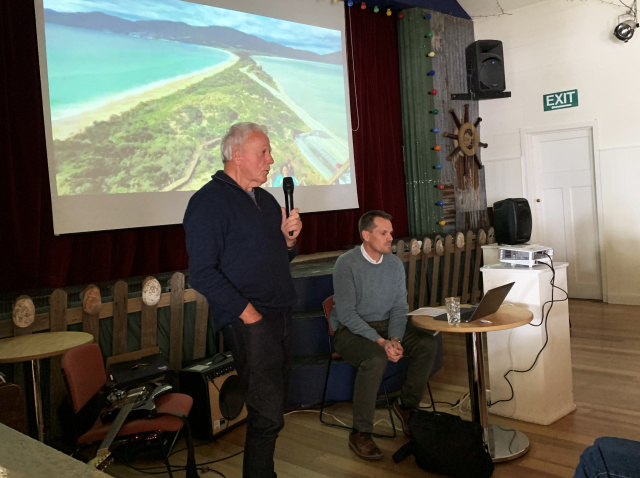
When we moved here permanently, I started to walk everywhere. So for example rather than drive to the shop, which for us was 700 metres away, I’d walk. And probably four or five times a week, I’d walk down to the shop and it became clear that I was walking through some amazing scenery.
Not scenery in the sense of the word “oh, isn’t that beautiful, I’ll take a couple of photos” but scenery in terms of there were birds in the trees, there were mammals on the ground, there were insects. All of these things were just in a short space of 700 metres.
Across that distance I counted between 40 and 50 different habitats. And different habitats mean that different animals are supported. From seabirds to shorebirds, through to urban birds such as sparrows and blackbirds, all the crows – the poor old crows get a hard time – but through to the swamp area, the wetland behind us. It’s one of only a few untouched wetlands left in Tasmania, although it’s very much at risk – and it has a nesting pair of raptors in there – swamp harriers.

Amazing creatures. You’ll see a swamp harrier fly up to a thousand metres sometimes and drop as its mating display. You don’t see that sort of thing every day, but that’s what happened to us.
As I became more and more aware of this, I began to learn how the world actually worked, rather than reading it in books and textbooks and photos and listening to lectures and so on and so forth. So over time I became to understand how much we, as human beings, are really part of the world.
It was a great learning experience. It took a long time and I’ve still got a lot to go. But its going to be worth the journey. And hopefully through sites like Kuno, we can pass that knowledge – not just the knowledge, but the understanding, and how you gain that understanding – on. So Kuno to my mind has to be much more active, where people use it as a resource to access the knowledge that’s out there.
I wanted to first draw a contrast for you. Most people recognise the Neck. If you Google or go to a website and search for Bruny Island, you’ll see a particular photo. There are hundreds and hundreds and hundreds of them. It’s what people call an iconic thing. I’m not sure if it’s the right use of the word, but every website says “here is an iconic view of Bruny Island.”
It’s an iconic view of a very small part of Bruny Island, and it misses the entire point of what the island is about. But that's what people come to see.
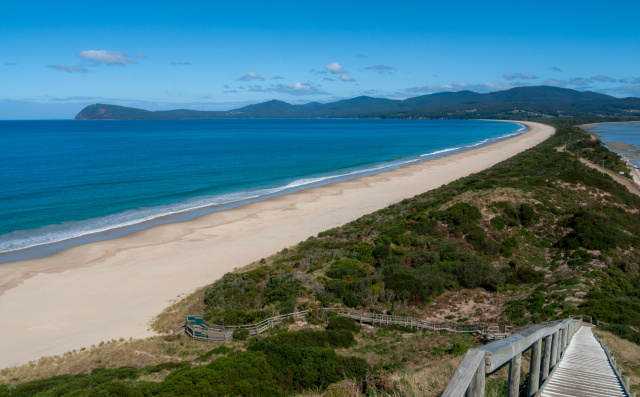
I also looked at Chat GPT for Bruny Island. It said “The Bruny Island Neck is an isthmus that connects North and South Bruny. Artificial intelligence is certainly artificial, but I don’t know about the intelligence. Because it says nothing about Bruny Island. It doesn’t even say anything about the Neck.
If we look for another perspective of the Neck, it’s harder to find and you get a totally different perspective. What you’re seeing is from the east to the west. You’re not seeing a strip of land that has a road on it, you’re seeing five different provinces, geological provinces.
That Neck, that sand bar is probably three to four thousand years old. It started to develop about six thousand years ago at the end of the last Ice Age. It has sediments from the North West Bay and Huon Rivers that deposited and became flooded on the western side, and sand that had washed from further out to sea was piled up through the waves. And so there was immediately a connection between the water to the left and the water to the right. But you can see they’re totally different environments.
As you move through from the east, we have an oceanic environment. It supports different animals and different plants and different formations, than on the left. There’s a great contrast and in between, you have a strip of terrestrial environment.
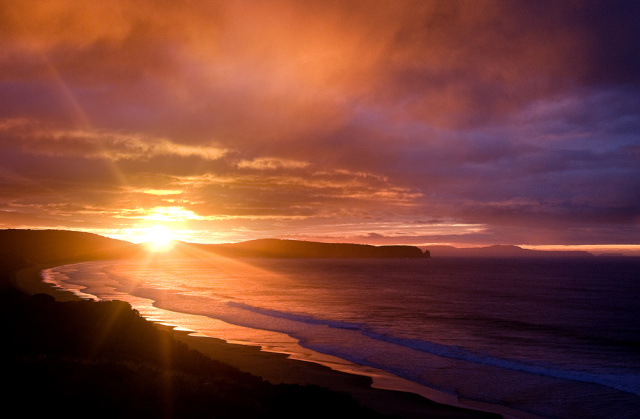
Five different provinces – you have the oceanic environment, you have the intertidal zone where the waves are coming up, then you have a narrow strip of land, then another intertidal environment at the edge, and when the tide goes out it uncovers wide sand flats.
To the west, that’s known as the benthic environment. Most of the animals live on the sea floor. On the land, you have a terrestrial environment supporting a very large range of plants and animals, including most of those that we find on Bruny Island. But unfortunately there are also cats there, and rabbits, which are devastating the native populations there.
And on the eastern side, you have the oceanic environment, with marine mammals. You have oceanic birds.
Of course, Chat GPT also mentions penguins. It says these are the iconic birds of Bruny Island. Well I’m sorry, but penguins are not the iconic birds of Bruny Island.
They are fantastic, amazing creatures but they’re not facing the same raft of problems – although they probably will in the future – that the forty-spotted pardalote and the swift parrots are, and many others. Once you start really looking at the landscape, you can go to the lookout and see upwards on any day of 20 different bird species.
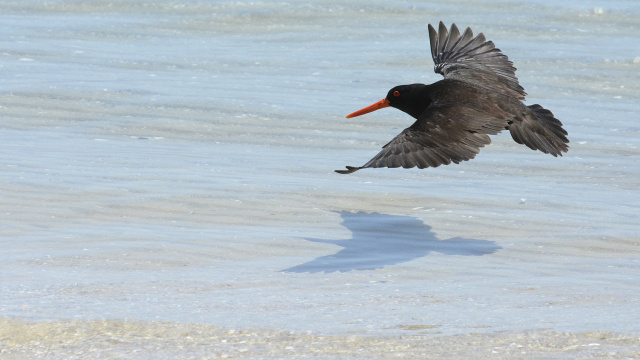
If you take the time and walk up the steps and look at the plants, you have an incredible assembly of plants that have been able to establish themselves in an extremely harsh environment, and they’re hanging on… they are keeping that Neck area relatively stable.
The Neck is what’s known as a temporary landform and it will disappear or change or move. We don’t know which. We certainly hear people say “when will the Neck break through?” Well, we don’t know that it will. But it will certainly change, and it will change dramatically. It’s highly likely for example that we can get sea level rise, more easterly storms. There are warming waters coming down from the north. A lot of the Neck will be eroded on the eastern side. It may even retreat. The whole thing may move to the west. It’s changing constantly.
When people think “it’s a permanent feature” – it isn’t. It’s nothing like it. It has already changed in the short term in the time Europeans have been here on this island. The population that lived here before – the Nuenonne - of course were able to adapt and continue their lifestyle over 60 thousand years. We can’t do that.

We drive cars across there. We have motor boats catch countless fish. The area to the west is a favourite breeding ground for stingrays.
If you go out in a small boat and have a look, 20 years ago you saw lots and lots and lots of stingrays. Today, you’re lucky to see a few. They just disappear. It has been overfished.
I saw a statistic just yesterday – since 1970, 68% of all species of plants, animals, insects, have disappeared from the earth. And that’s the same age as our eldest son. In his lifetime, those have disappeared.
Just finally I’d like to say if we can get Kuno working, we can get people to understand that this is a crisis. We have to understand what’s going on here.
We have to understand it, we have to build up our knowledge, so that we can take the actions that at least modify the effects of social, economic and biological effects that climate change will have on us.
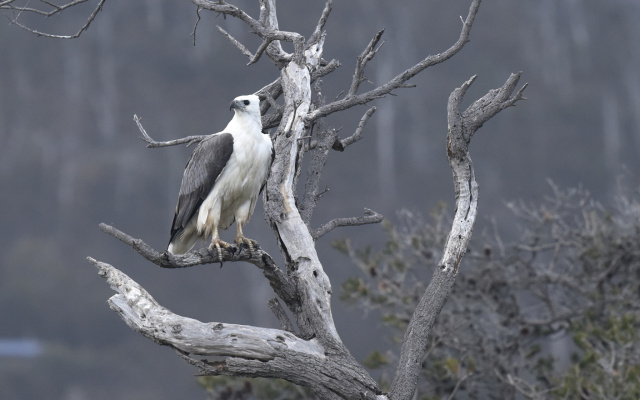
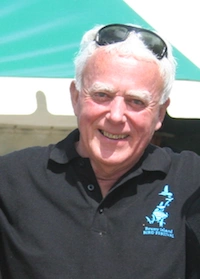
Bob Graham
Introduction by Dr Phill Pullinger, Kuno Director and CEO:
Bob grew up on the north-west coast of Tassie and says that his concept of birds as a kid was sparrows and crows. But a formative trip with some friends in the 1970s to the Coorong was one of the thing that catalysed for him a lifelong love for birds.
And he spent a lifetime committed to celebrating and protecting the Natural world, in a variety of ways – from time as a Labor MP in Parliament, to extensive work in planning and conservation legal work, to one half of the amazing Bob and Marg duo on Bruny, who have dedicated decades of work committed to the Natural landscapes and ecology of this place – particularly through the Bruny Environment Network. Thanks Bob.
--
Bob Graham: Thank you Phill. I’d just like to draw a small comparison to start off with. Consider this: Bruny Island is exactly the same size as the Gaza strip – now look at what’s happening and how that has been totally and absolutely destroyed. It makes what we have here even more precious.
Marg and I have lived on Bruny Island for 24 and a half years. We bought a place here in 1977 and enjoyed many weekends and school holidays and all that sort of stuff down here. And in so doing, we came to love the place. Not just the fact that it was in itself beautiful, as described in tourist brochures and so on, but that it had values that emerged over time.

When we moved here permanently, I started to walk everywhere. So for example rather than drive to the shop, which for us was 700 metres away, I’d walk. And probably four or five times a week, I’d walk down to the shop and it became clear that I was walking through some amazing scenery.
Not scenery in the sense of the word “oh, isn’t that beautiful, I’ll take a couple of photos” but scenery in terms of there were birds in the trees, there were mammals on the ground, there were insects. All of these things were just in a short space of 700 metres.
Across that distance I counted between 40 and 50 different habitats. And different habitats mean that different animals are supported. From seabirds to shorebirds, through to urban birds such as sparrows and blackbirds, all the crows – the poor old crows get a hard time – but through to the swamp area, the wetland behind us. It’s one of only a few untouched wetlands left in Tasmania, although it’s very much at risk – and it has a nesting pair of raptors in there – swamp harriers.

Amazing creatures. You’ll see a swamp harrier fly up to a thousand metres sometimes and drop as its mating display. You don’t see that sort of thing every day, but that’s what happened to us.
As I became more and more aware of this, I began to learn how the world actually worked, rather than reading it in books and textbooks and photos and listening to lectures and so on and so forth. So over time I became to understand how much we, as human beings, are really part of the world.
It was a great learning experience. It took a long time and I’ve still got a lot to go. But its going to be worth the journey. And hopefully through sites like Kuno, we can pass that knowledge – not just the knowledge, but the understanding, and how you gain that understanding – on. So Kuno to my mind has to be much more active, where people use it as a resource to access the knowledge that’s out there.
I wanted to first draw a contrast for you. Most people recognise the Neck. If you Google or go to a website and search for Bruny Island, you’ll see a particular photo. There are hundreds and hundreds and hundreds of them. It’s what people call an iconic thing. I’m not sure if it’s the right use of the word, but every website says “here is an iconic view of Bruny Island.”
It’s an iconic view of a very small part of Bruny Island, and it misses the entire point of what the island is about. But that's what people come to see.

I also looked at Chat GPT for Bruny Island. It said “The Bruny Island Neck is an isthmus that connects North and South Bruny. Artificial intelligence is certainly artificial, but I don’t know about the intelligence. Because it says nothing about Bruny Island. It doesn’t even say anything about the Neck.
If we look for another perspective of the Neck, it’s harder to find and you get a totally different perspective. What you’re seeing is from the east to the west. You’re not seeing a strip of land that has a road on it, you’re seeing five different provinces, geological provinces.
That Neck, that sand bar is probably three to four thousand years old. It started to develop about six thousand years ago at the end of the last Ice Age. It has sediments from the North West Bay and Huon Rivers that deposited and became flooded on the western side, and sand that had washed from further out to sea was piled up through the waves. And so there was immediately a connection between the water to the left and the water to the right. But you can see they’re totally different environments.
As you move through from the east, we have an oceanic environment. It supports different animals and different plants and different formations, than on the left. There’s a great contrast and in between, you have a strip of terrestrial environment.

Five different provinces – you have the oceanic environment, you have the intertidal zone where the waves are coming up, then you have a narrow strip of land, then another intertidal environment at the edge, and when the tide goes out it uncovers wide sand flats.
To the west, that’s known as the benthic environment. Most of the animals live on the sea floor. On the land, you have a terrestrial environment supporting a very large range of plants and animals, including most of those that we find on Bruny Island. But unfortunately there are also cats there, and rabbits, which are devastating the native populations there.
And on the eastern side, you have the oceanic environment, with marine mammals. You have oceanic birds.
Of course, Chat GPT also mentions penguins. It says these are the iconic birds of Bruny Island. Well I’m sorry, but penguins are not the iconic birds of Bruny Island.
They are fantastic, amazing creatures but they’re not facing the same raft of problems – although they probably will in the future – that the forty-spotted pardalote and the swift parrots are, and many others. Once you start really looking at the landscape, you can go to the lookout and see upwards on any day of 20 different bird species.

If you take the time and walk up the steps and look at the plants, you have an incredible assembly of plants that have been able to establish themselves in an extremely harsh environment, and they’re hanging on… they are keeping that Neck area relatively stable.
The Neck is what’s known as a temporary landform and it will disappear or change or move. We don’t know which. We certainly hear people say “when will the Neck break through?” Well, we don’t know that it will. But it will certainly change, and it will change dramatically. It’s highly likely for example that we can get sea level rise, more easterly storms. There are warming waters coming down from the north. A lot of the Neck will be eroded on the eastern side. It may even retreat. The whole thing may move to the west. It’s changing constantly.
When people think “it’s a permanent feature” – it isn’t. It’s nothing like it. It has already changed in the short term in the time Europeans have been here on this island. The population that lived here before – the Nuenonne - of course were able to adapt and continue their lifestyle over 60 thousand years. We can’t do that.

We drive cars across there. We have motor boats catch countless fish. The area to the west is a favourite breeding ground for stingrays.
If you go out in a small boat and have a look, 20 years ago you saw lots and lots and lots of stingrays. Today, you’re lucky to see a few. They just disappear. It has been overfished.
I saw a statistic just yesterday – since 1970, 68% of all species of plants, animals, insects, have disappeared from the earth. And that’s the same age as our eldest son. In his lifetime, those have disappeared.
Just finally I’d like to say if we can get Kuno working, we can get people to understand that this is a crisis. We have to understand what’s going on here.
We have to understand it, we have to build up our knowledge, so that we can take the actions that at least modify the effects of social, economic and biological effects that climate change will have on us.

You might like...

Bruny Island launch: CEO Phill Pullinger on the Kuno concept

Bruny Island launch: Dr Tonia Cochran on its global significance

The great Tasmanian bird count

Walking on Bruny Island
Newsletter
Sign up to keep in touch with articles, updates, events or news from Kuno, your platform for nature
